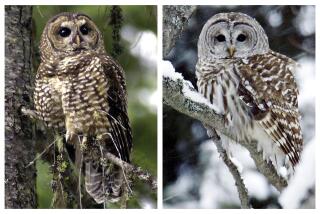Protection sought for San Bernardino flying squirrel
- Share via
Environmentalists have petitioned the U.S. Fish and Wildlife Service to list the San Bernardino flying squirrel, a nocturnal glider native to Southern California mountains, as an endangered species threatened by climate change.
The petition, filed Tuesday by the Tucson-based Center for Biological Diversity, is another salvo in the nascent effort to combat global warming through the Endangered Species Act.
The move comes after the federal government in 2008 granted protected status to the polar bear, based on shrinking ice sheets caused by climate change.
Earlier this year, the Obama administration denied the center’s petition to list the American pika, a rabbit-like mammal that lives at high elevations in nine Western states, saying that the species was abundant enough to survive climate change.
With Congress deadlocked on global warming legislation, environmentalists see the Endangered Species Act as a way to force regulation of coal-fired power plants and industrial facilities that spew carbon dioxide and other greenhouse gases that trap heat in the atmosphere.
As the climate warms from these greenhouse gases, animals and plants in cooler regions are threatened with extinction, the petitions argue. Under the Endangered Species Act, the government is obligated to protect threatened forms of life, and, arguably, could do so through enacting curbs on greenhouse gases, even from sources outside the creature’s immediate habitat.
The center also filed petitions asking federal protection on climate change grounds for the ‘I’iwi, a Hawaiian songbird; the white-tailed ptarmigan, a grouse-like bird of the Rocky Mountains; and Bicknell’s thrush, a northeastern U.S. songbird.
“Climate change will have disproportionate impacts on species that live at high elevations,” said Noah Greenwald, the center’s endangered species program director. “These four species are literally going to be pushed off the top of the mountain.”
However, Damien Schiff, an attorney with the Sacramento-based Pacific Legal Foundation, a conservative nonprofit group, called the petitions “speculative conjecture about what might or might not … affect these species. The law doesn’t allow the Fish and Wildlife Service to substitute a crystal ball for hard data.” The foundation has filed a lawsuit challenging the polar bear’s listing.
The San Bernardino flying squirrel, a subspecies of the northern flying squirrel, has parachute-like panels of skin that stretch from wrist to ankle, allowing it to glide for 300 feet or more between trees. It lives year-round in Southern California’s high-elevation conifer forests, and feeds on truffle fungi that thrive among large trees and downed logs.
The San Bernardino flying squirrel is thought to have disappeared from the San Jacinto Mountains in recent decades, and the remaining population appears to be confined to the higher peaks of the San Bernardino Mountains. Truffles, its primary food, depend on wet, cool conditions that could be altered by climate-induced drought. Air pollution, urban development and forest-clearing also may be affecting the squirrel’s range, according to the petition.
margot.roosevelt@latimes.com
More to Read
Sign up for Essential California
The most important California stories and recommendations in your inbox every morning.
You may occasionally receive promotional content from the Los Angeles Times.














